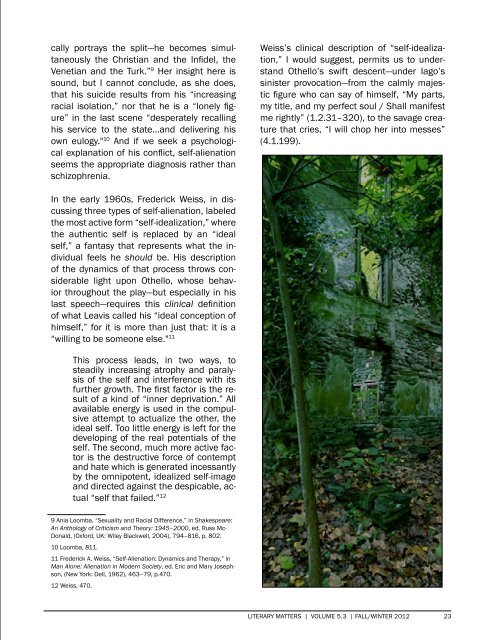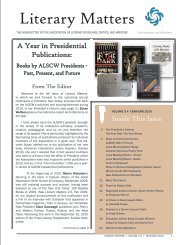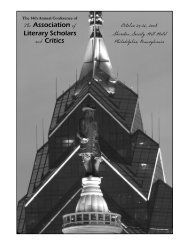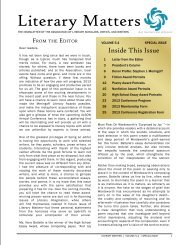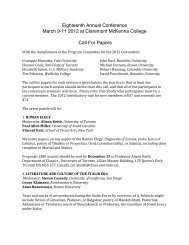There is much that is sound in Leavis’s view<strong>of</strong> Othello as a victim <strong>of</strong> self-idealization, aslater critics have <strong>of</strong>ten conceded. 7 But what Iwould urge is that both Eliot <strong>and</strong> Leavis err inregarding Othello’s last speech as arising froma “histrionic intent.” Theatrical it is, but selfdramatization,“cheering himself up,” is nothis motive in speaking at this point, <strong>and</strong> onlyby ignoring what obviously is his motive—to killhimself—could they fall into this error.Consider this: Lodovico has not left Othello asa loose cannon free to roam about the stage,but a weaponless prisoner in the grip <strong>of</strong> guardswho are about to lead him away. It is not aneasy task to commit suicide under such conditions!Why does he speak? To halt the suddenexodus <strong>and</strong> free himself so that he may die ashe chooses to: “upon a kiss” (5.2.368).His immediate motive is to free himself. Freedom,<strong>of</strong> course, has been an abiding concern <strong>of</strong>his throughout the play: “The Moor is <strong>of</strong> a free<strong>and</strong> open nature,” Iago muses as he deviseshis plan <strong>of</strong> attack at the end <strong>of</strong> Act I (1.3.400),<strong>and</strong> everything we have witnessed <strong>of</strong> Othelloup to that moment inclines us to agree. Yethis “free nature” is not marked by a carefreeoutlook; on the contrary, his need to feel unconstrainedis so powerful that preserving hisfreedom appears always to be on his mind. Ofhis marriage, for instance, he tells Iago, “Butthat I love the gentle Desdemona, / I would notmy unhoused free condition / Put into circumscription<strong>and</strong> confine / For the sea’s worth”(1.2.25–28).To view his marriage as “circumscription <strong>and</strong>7 Barbara Everette was one such, but nevertheless felt the view thatOthello is “noble” is not sentimental (“Reflections on the Sentimentalist’sOthello,” Critical Quarterly, 3 [1961], 127–39; repr. inShakespeare: An Anthology <strong>of</strong> Criticism <strong>and</strong> Theory: 1945–2000, ed.Russ McDonald [Malden, MA: Blackwell, 2004], 152–63). Others,like Robert B. Heilman in Magic in the Web: Action <strong>and</strong> Language inOthello, (Lexington: University <strong>of</strong> Kentucky Press, 1956), cite Leavis’sviews with approval (145ff.). Actually, Leavis’s theories remainedinfluential for decades; Joan Lord Hall points out that the NationalTheatre production <strong>of</strong> the play in 1964, with Lawrence Olivier as Othello,was heavily indebted to his outlook, as was Stuart Burge’s filmversion in the following year (Othello: A Guide to the Play [Westport,CT: Greenwood Press, 1999], 170ff.).confine[ment]” implies a somewhat claustrophobicfear <strong>and</strong> points to the means Iago discoversto bring him down. “The essential traitor,”as Leavis remarked, “is within the gates,”<strong>and</strong> it is by directing his remarks to that “traitor”that Iago is able to “circumscribe <strong>and</strong> confine”his victim. “Circumscription,” we should note, isbut one <strong>of</strong> a rather astounding number <strong>of</strong> “circum-”words—seven in all—that Shakespeareemploys in this play, all creating the sense <strong>of</strong>enclosure. “Circumstance,” for instance, appearsin the opening scene when Iago is explainingto Roderigo how Othello rid himself <strong>of</strong>those seeking to advance Iago’s suit:But he, as loving his own pride <strong>and</strong> purposes,Evades them with a bombast circumstanceHorribly stuff’d with epithets <strong>of</strong> war….(1.1.13–15)Kittredge glosses “bombast circumstance”here as “bombastic circumlocution,” 8 <strong>and</strong> wesee that Othello is employing language to confinehis listeners’ purposes before they can restricthis own. And note how well Iago’s description<strong>of</strong> this initial use <strong>of</strong> the “Othello magic”accords with its use in his last speech, for dowe not see him there again deploying “bombastcircumstance” to further “his own pride<strong>and</strong> purposes”?“Circumstance” appears most famously, <strong>of</strong>course, in the“[p]ride, pomp, <strong>and</strong> circumstance<strong>of</strong> glorious war” (3.3.359), a phrase thatspeaks revealingly <strong>of</strong> what Othello values in his“occupation.” And that “circumcised dog” thatmust not go unmentioned suddenly becomesthe focus <strong>of</strong> his wrath in his last speech, directingit against his own breast (5.2.64).The only discussion <strong>of</strong> this “inner Turk” <strong>of</strong> Othello’sthat I know <strong>of</strong> comes from a post-colonialcritic, Ania Loomba, who sees Othello as “anear schizophrenic whose last speech graphi-8 Irving Ribner <strong>and</strong> George Lyman Kittredge, eds., The CompleteWorks <strong>of</strong> Shakespeare (Waltham, MA: Ginn <strong>and</strong> Company, 1971),1157.22 LITERARY MATTERS | VOLUME <strong>5.3</strong> | FaLL/WINTER 2012
cally portrays the split—he becomes simultaneouslythe Christian <strong>and</strong> the Infidel, theVenetian <strong>and</strong> the Turk.” 9 Her insight here issound, but I cannot conclude, as she does,that his suicide results from his “increasingracial isolation,” nor that he is a “lonely figure”in the last scene “desperately recallinghis service to the state…<strong>and</strong> delivering hisown eulogy." 10 And if we seek a psychologicalexplanation <strong>of</strong> his conflict, self-alienationseems the appropriate diagnosis rather thanschizophrenia.Weiss’s clinical description <strong>of</strong> “self-idealization,”I would suggest, permits us to underst<strong>and</strong>Othello’s swift descent—under Iago’ssinister provocation—from the calmly majesticfigure who can say <strong>of</strong> himself, “My parts,my title, <strong>and</strong> my perfect soul / Shall manifestme rightly” (1.2.31–320), to the savage creaturethat cries, “I will chop her into messes”(4.1.199).In the early 1960s, Frederick Weiss, in discussingthree types <strong>of</strong> self-alienation, labeledthe most active form “self-idealization,” wherethe authentic self is replaced by an “idealself,” a fantasy that represents what the individualfeels he should be. His description<strong>of</strong> the dynamics <strong>of</strong> that process throws considerablelight upon Othello, whose behaviorthroughout the play—but especially in hislast speech—requires this clinical definition<strong>of</strong> what Leavis called his “ideal conception <strong>of</strong>himself,” for it is more than just that: it is a“willing to be someone else." 11This process leads, in two ways, tosteadily increasing atrophy <strong>and</strong> paralysis<strong>of</strong> the self <strong>and</strong> interference with itsfurther growth. The first factor is the result<strong>of</strong> a kind <strong>of</strong> “inner deprivation.” Allavailable energy is used in the compulsiveattempt to actualize the other, theideal self. Too little energy is left for thedeveloping <strong>of</strong> the real potentials <strong>of</strong> theself. The second, much more active factoris the destructive force <strong>of</strong> contempt<strong>and</strong> hate which is generated incessantlyby the omnipotent, idealized self-image<strong>and</strong> directed against the despicable, actual“self that failed.” 129 Ania Loomba, “Sexuality <strong>and</strong> Racial Difference,” in Shakespeare:An Anthology <strong>of</strong> Criticism <strong>and</strong> Theory: 1945–2000, ed. Russ Mc-Donald, (Oxford, UK: Wiley Blackwell, 2004), 794–816, p. 802.10 Loomba, 811.11 Frederick A. Weiss, “Self-Alienation: Dynamics <strong>and</strong> Therapy,” inMan Alone: Alienation in Modern Society, ed. Eric <strong>and</strong> Mary Josephson,(New York: Dell, 1962), 463–79, p.470.12 Weiss, 470.LITERARY MATTERS | VOLUME <strong>5.3</strong> | Fall/winter 2012 23


